ShindoL writes a lot of weird shit.No really, in this book, Link got raped by her step uncle till the day he died and Link inherited his sword to fight evil.
But since Link is a woman, she is too weak to fight Ganon. She is defeated in the final battle and raped till they live happily ever after.
 Problem, senpai?
Problem, senpai?
-
Welcome to rpgcodex.net, a site dedicated to discussing computer based role-playing games in a free and open fashion. We're less strict than other forums, but please refer to the rules.
"This message is awaiting moderator approval": All new users must pass through our moderation queue before they will be able to post normally. Until your account has "passed" your posts will only be visible to yourself (and moderators) until they are approved. Give us a week to get around to approving / deleting / ignoring your mundane opinion on crap before hassling us about it. Once you have passed the moderation period (think of it as a test), you will be able to post normally, just like all the other retards.
You are using an out of date browser. It may not display this or other websites correctly.
You should upgrade or use an alternative browser.
You should upgrade or use an alternative browser.
NSFW Best Thread Ever [No SJW-related posts allowed]
- Thread starter Lord Chambers
- Start date
So? According to the Codex Fallout 3 isn't a real RPG either.Kotaku: Fallout 3 Isn't Really An RPG
Fallout 3 doesn’t follow the same basic formula for open-world sandbox games that has produced some truly great games, from Grand Theft Auto V to The Witcher 3. But what if Bethesda wasn’t making an open-world sandbox RPG at all?
When Grand Theft Auto III released in 2001, it was a revelation. Sure, open-world games had existed prior, including Rockstar’s own Body Harvest, back when Rockstar was still known as DMA Design. But it was GTA3 that changed the landscape of gaming forever. In a post-GTAworld, it seemed like everyone was scrambling to make open-world games. By the seventh generation, it seemed like every major publisher had a game influenced by Grand Theft Auto.
Open-world games work something like this: the player exists in a large, 3D world, tackling it from a third-person perspective. Players travel between various points to complete or engage in missions. Many of the games feature cars, and those that don’t often include other means of quick traversal, like parkour or grappling hooks. The world map is peppered with icons for additional activities not relevant to the main story, many of which are repeated throughout the world, most often in the form of various challenges and minigames. Most of the people you encounter in the game world don’t have lives of their own—they disappear as soon as you get far enough away from them.
You can find this kind of gameplay in Grand Theft Auto V, as illustrated by its map:

And, of course, here’s Assassin’s Creed Unity:
2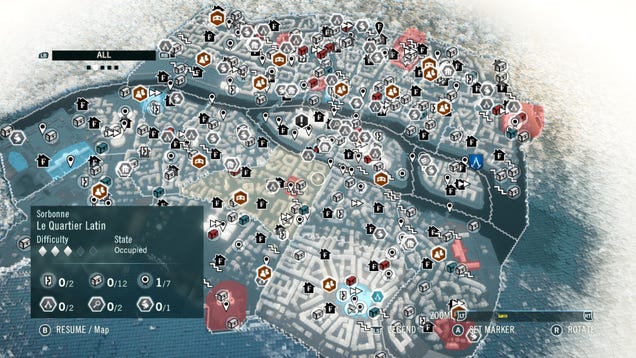
Batman: Arkham Knight:
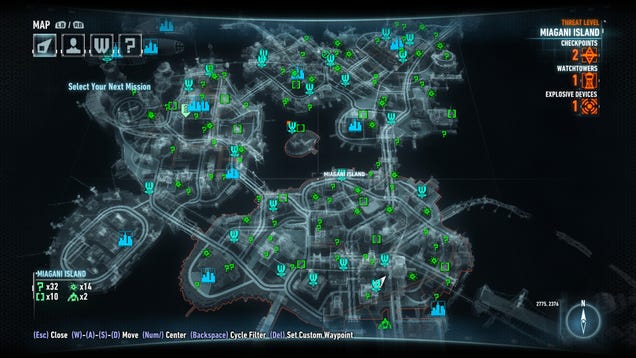
From The Witcher 3 to Sunset Overdrive to Shadow of Mordor to Far Cry 4, open-world games almost all work the exact same way.
At a glance, Bethesda’s games might appear to have a lot in common traditional sandbox games, with their big, open worlds, plethora of map markers, and long travel times, but playing through games like Fallout 3 is a completely different experience than the traditional sandbox experience.
Last time we talked about Fallout 3, we looked at three basic things that made it awesome: it uses boredom to propel you out into the Wasteland, then it sends you on missions all around the map, not to pad out its content, but to distract you, leading you into its great world, where it occupies your attention by constantly asking you to think about the world you’re exploring.
Combine those ideas with Fallout 3’s approach to the world and its inhabitants, and the game’s entire design starts to make sense. It’s breaking the rules, but it’s got a reason for that.
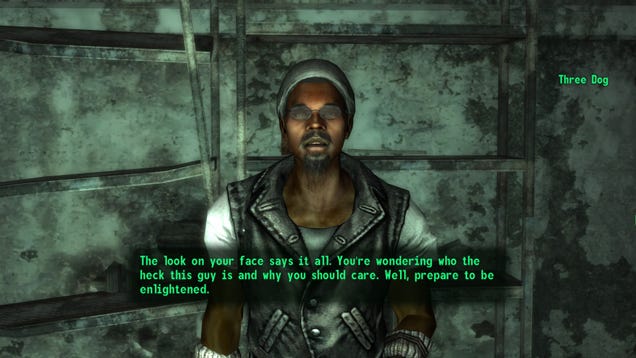
The Difference Between Abstraction and Simulation
All games can be arranged on a single spectrum. On one end, you have abstraction, and on the other, you have simulation.
Abstraction is the idea that you can take something and distill into a simple, easily-understood form. Chess is an abstract game: rather than presenting a real battle, it presents the idea of one. Simulation, on the other hand, is a replication of reality. Total War games offer a greater level of simulation than chess by creating individual units, simulating how they might do damage based on their position in the world, and so on.
Abstractions are often things like taking turns, button combos, regenerating health, and so on. It treats video games as games. Simulation elements tend to focus on things that make the game world a real space, like physics or advanced artificial intelligence. It treats video games as virtual realities.
345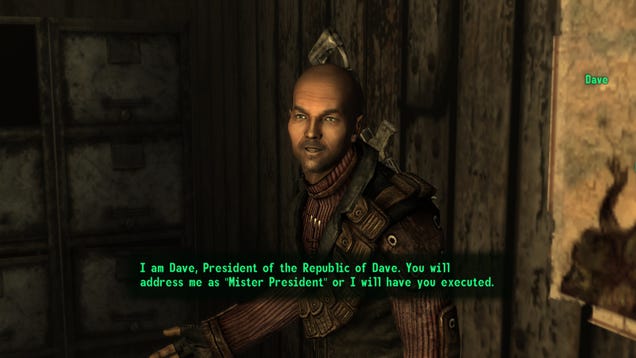
Most open world games offer abstract scenarios, bite-sized chunks of gameplay set in a larger overworld. Once you know how to defuse a bomb in Arkham Knight, you can simply repeat what you’ve learned in any bomb-defusing encounter the game presents. Open-world developers take a single action and make a repeatable mini-game out of it.
A chest in Unity simply involves pressing a single button. A tank battle in Arkham Knight limits you to a tiny location and requires you to dodge enemy attacks while firing at them with the Batmobile’s main gun. It gets predictable. Players feel obligated to solve over 200 puzzles (two hundred puzzles!) because they want to complete the game (the final scenes in Arkham Knightaren’t available until you solve all the puzzles), or because the game has a little meter that essentially says, “Hey. You. You are only 94% complete. You left me unfinished!”
Bethesda’s games are closer to simulations than abstractions. Check out this world map:
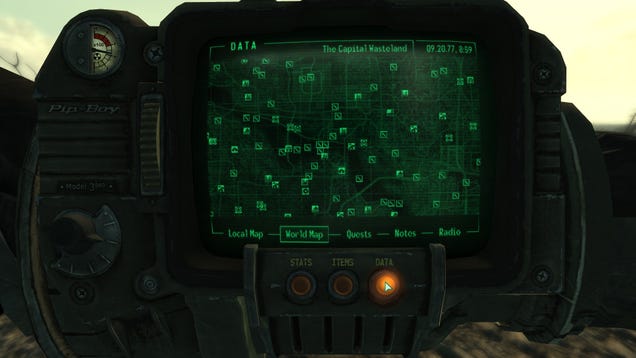
At first, it might look like any other open-world game. You’ve got a map, you’ve got markers on the map. No big difference, right?
The difference from traditional open-world is that these are all distinct locations, rather than discrete events. You won’t happen upon a location in the Wasteland only to have someone warn you that leaving the area will cause an event to cease, for instance. You won’t be able to predict what you’re going to do at any given location simply by looking at its map marker. You might get the general gist, knowing that a vault means underground exploration, for instance, but Vault 108, home to Gary, is very different than Vault 106, the vault of hallucinations.
I’ve come across rooms in Fallout 3 where, long before, drug-addled psychos had attempted to climb the walls with plungers, falling to their deaths. I found a bizarre grocery store that had been converted into a Rube Goldberg machine. I once stumbled across a cave by accident; inside, I found a large recreational facility for raiders, which included prison cells stuffed with children’s toys and female mannequins with big, red light bulbs replacing their breasts. I’ve stumbled across completely abandoned villages and piles of corpses. As I was writing this, I watched a pack of Super Mutants shoot down a Vertibird.
They’re locations, not minigames. Each place has its own sense of history.
What this means is that, when you see something pop up on your compass, you have no idea what you’re going to get into when you get there. You are an inhabitant of Fallout 3’s world, which means that every location is new, fresh, and interesting. No two areas play out the exact same way, even if they have the same elements. Nothing is predictable.
But what about Fallout 3’s other inhabitants?
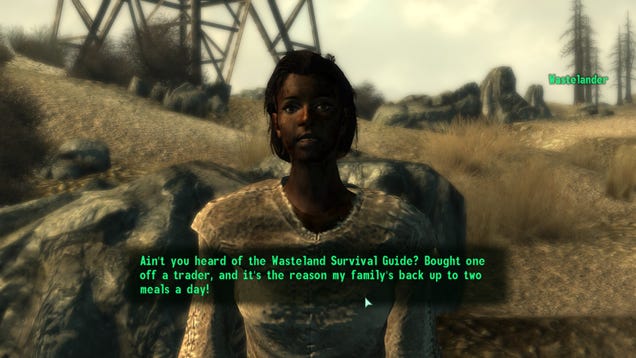
A World That Lives And Breathes Without You
If you’ve played a game like Grand Theft Auto V, you know just how crazy car crashes can get. Of course, you also know that it doesn’t really matter, because none of the people involved are ‘actually’ people. You can’t follow them to their homes or jobs, and even if you could, most of the buildings in GTA aren’t actually buildings for these people to inhabit. They’re boxes dressed to look like buildings.
Most open-world video games present a breathtaking virtual tableau, but that’s all it is. Visually,Fallout 3’s world seems simplistic itself, but what it lacks in detailed graphics, it more than makes up for in its world. The people of Fallout 3 live their own lives. One character, for instance, wakes up every morning, eats breakfast for an hour, goes to work, then returns home to sleep. Hundreds of other characters in the world act just as he does, living, breathing, eating, sleeping, and even dying, all entirely independent of you. Some characters ‘spawn’ in a more traditional sense, but a massive number of characters are simply people going about their lives in the Capital Wasteland.
As if that weren’t enough, Bethesda takes this a step further, simulating not just bodies, but body parts. One thing that sets Fallout 3 apart from every other first-person game in the world is the VATS system, a real-time adaptation of turn-based gameplay. Fallout 3 allows you to target individual enemy body parts: shoot one enemy in the leg, and he’ll begin limping. Shoot another in her arm, and she’ll drop her gun. You can even shoot the gun! If it breaks, your opponent will have to switch to something else.
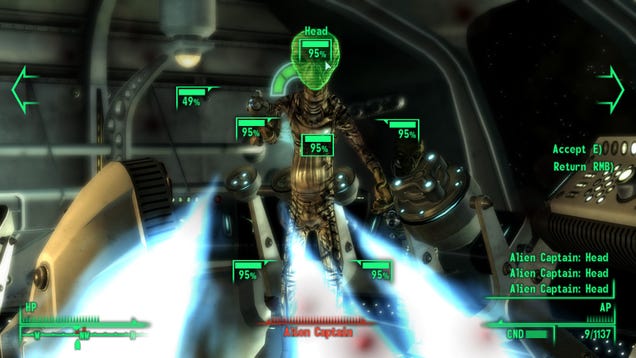
Even better, enemies might loot a fallen friend, using their potentially better weapons against you. Ever seen anything like that in Assassin’s Creed? Fallout 3 enemies have varying levels of courage as well. If you hurt some enemies enough, you’ll frighten them and they’ll flee.
Some characters take lengthy journeys through the world; you can follow James, the player character’s father, through the world in real-time after rescuing him from Vault 112. Merchants that roam the wastelands often have set paths between settlements where they can run afoul of super mutants, raiders, or wildlife.
Even when life isn’t completely simulated, it still gives the impression of a real world. Certain areas in New Vegas, Obsidian’s follow-up to Bethesda’s Fallout 3, spawn the same monsters in the same locations every single time. It feels more like a traditional game: you know exactly which zones will have you fighting exactly the same mix of half a dozen deathclaws every time.Fallout 3 populates its world in a way that feels much more natural. Yao guai, for instance, will show up the further away you get from downtown DC. Super Mutants live throughout the DC area.
It makes sense that the super mutants would hole up in irradiated ruins, while the wildlife would stick to the wilds outside. New Vegas uses predictable enemy types to establish zones that only players of certain levels can enter—a more abstract approach to world design. The games may seem virtually identical, utilizing many of the same assets and running on the same engine, but they’re very different.
Bethesda’s open-world games do things with AI and population that other games don’t even attempt, and the result is a world that feels more vibrant and alive.
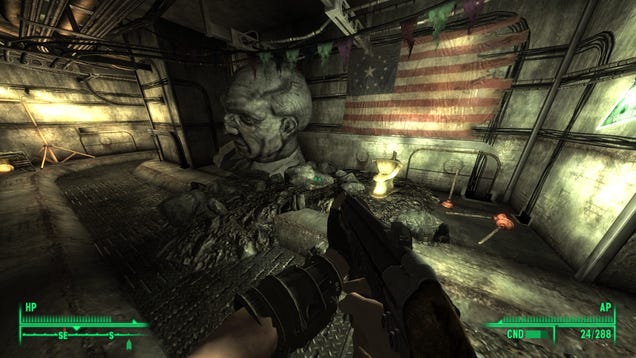
There’s a History Here
By 1980 or so, RPGs began to evolve, with two distinct schools of design. Origin’s Ultima heads towards more simulation-oriented design, and their other games, like Wing Commander, follow suit. Interplay, Black Isle, and Bioware, on the other hand, focus more on translating traditional, abstract RPG structure into video game mechanics.
One developer, Looking Glass, had this crazy idea that they could combine the simulation components of the flight simulators they were making with the adventuring elements of an RPG. The result, Ultima Underworld—yes, it’s related to Ultima—ended up being one of the most influential games of all time, with games from Portal to Dead Space to Bioshock owing something to it. Ultima Underworld even had an impact on Bethesda.
You can see the RPG elements in Looking Glass’ games; System Shock 2, for instance, gave players “cyber modules,” which worked like skill points, allowing players to upgrade at various stations throughout the terminals. Despite this, Looking Glass’ games often downplayed the traditional RPG elements, seeking to remove the abstractions from them, pushing simulation elements instead.
They had effectively created a new genre entirely. It had RPG elements, but wasn’t really an RPG. It had simulation elements, but it wasn’t a simulator. They called it the “immersive sim.”
Some people argue that Bethesda doesn’t make very good RPGs, especially fans of the Obsidian-developed Fallout: New Vegas, and that’s fine, because Bethesda doesn’t make RPGs. They make immersive sims.
In other words…
6
Fallout 3 is not an RPG
RPGs and immersive sims both focus on the same general idea that the player is free to interact in a world as they see fit. RPGs are more abstract, relying on obvious statistics and dice rolls to determine what happens and how. Immersive sims attempt to simulate all of this, keeping the abstract numbers in the background.
Fallout 3 and Fallout: New Vegas appeal to very different crowds for precisely this reason. If you’re into the immersion, you’re probably going to enjoy Fallout 3’s brilliantly-designed world. If you’re an RPG fan, New Vegas is probably your thing.
Fallout 3 doesn’t really break the rules, it just follows a different set. Fallout 3 is neither RPG nor open-world sandbox. It’s a game born from the immersive sim offshoot of RPGs. Fallout 3 is a great game because everything it does works towards the goal of creating a living, breathing world. What’s cooler than that?
Crooked Bee, this article will make your head explode.
It's one of those articles that began with the author having an idea, made no sense mid-way but was published anyway.
Seriously, even if you go with his logic, why fucking Fallout 3 - the game about ransacking 200-year old supermarkets - being praised for "brilliantly-designed world", of all things? Has the guy even played Morrowind? And Fallout 3 still have attributes and stuffies like magical pants of +5 speech - wouldn't Skyrim be a better example of "non-RPG" that keeps the abstract systems on the background?
Seriously, even if you go with his logic, why fucking Fallout 3 - the game about ransacking 200-year old supermarkets - being praised for "brilliantly-designed world", of all things? Has the guy even played Morrowind? And Fallout 3 still have attributes and stuffies like magical pants of +5 speech - wouldn't Skyrim be a better example of "non-RPG" that keeps the abstract systems on the background?
thesoup
Arcane
- Joined
- Oct 13, 2011
- Messages
- 7,599
To all of you guys who didn't read the kotaku article - just read the last paragraph. A proper title would be how "Fallout 3 isn't merely just an RPG". It's about F3 being an immersive sim and offering immershun and a brilliantly crafted believable world like none other. It's a game that has essentially been brought to life, while Fallout: New Vegas is, according to the author, a more by-the-books RPG who appeals more to d20 rollers rather than people who want to immerse themselves in video games.
SerratedBiz
Arcane
- Joined
- Mar 4, 2009
- Messages
- 4,143
Hundreds of other characters in the world act just as he does, living, breathing, eating, sleeping, and even dying, all entirely independent of you. (...)
As if that weren’t enough, Bethesda takes this a step further, simulating not just bodies, but body parts. One thing that sets Fallout 3 apart from every other first-person game in the world is the VATS system

Baron Dupek
Arcane
- Joined
- Jul 23, 2013
- Messages
- 1,870,829
Everyone remembers this mod for Fallout 2 I am sure:

modders gonna mod
It's double infuriating when you know that there's only few mods for FO1/FO2 and they still managed to get THIS.
Bohaterów?Would've been hotter with the real male Link + forced feminization.
Prądem?
For nonpotatos - it's from Sexmisja (Sexmission). Boobs here and here, but it's actual parody of totalitarian reign.
BTW. Great people like Einstein were women, but bad one were males obviously
BTW. Great people like Einstein were women, but bad one were males obviously
- Joined
- Feb 17, 2014
- Messages
- 596
heres the source if anyones interestedNo really, in this book, Link got raped by her step uncle till the day he died and Link inherited his sword to fight evil.
But since Link is a woman, she is too weak to fight Ganon. She is defeated in the final battle and raped till they live happily ever after.
Excidium II
Self-Ejected

:mrpresident:
Kotaku: Fallout 3 Isn't Really An RPG
Fallout 3 doesn’t follow the same basic formula for open-world sandbox games that has produced some truly great games, from Grand Theft Auto V to The Witcher 3. But what if Bethesda wasn’t making an open-world sandbox RPG at all?
When Grand Theft Auto III released in 2001, it was a revelation. Sure, open-world games had existed prior, including Rockstar’s own Body Harvest, back when Rockstar was still known as DMA Design. But it was GTA3 that changed the landscape of gaming forever. In a post-GTAworld, it seemed like everyone was scrambling to make open-world games. By the seventh generation, it seemed like every major publisher had a game influenced by Grand Theft Auto.
Open-world games work something like this: the player exists in a large, 3D world, tackling it from a third-person perspective. Players travel between various points to complete or engage in missions. Many of the games feature cars, and those that don’t often include other means of quick traversal, like parkour or grappling hooks. The world map is peppered with icons for additional activities not relevant to the main story, many of which are repeated throughout the world, most often in the form of various challenges and minigames. Most of the people you encounter in the game world don’t have lives of their own—they disappear as soon as you get far enough away from them.
You can find this kind of gameplay in Grand Theft Auto V, as illustrated by its map:

And, of course, here’s Assassin’s Creed Unity:
2
Batman: Arkham Knight:

From The Witcher 3 to Sunset Overdrive to Shadow of Mordor to Far Cry 4, open-world games almost all work the exact same way.
At a glance, Bethesda’s games might appear to have a lot in common traditional sandbox games, with their big, open worlds, plethora of map markers, and long travel times, but playing through games like Fallout 3 is a completely different experience than the traditional sandbox experience.
Last time we talked about Fallout 3, we looked at three basic things that made it awesome: it uses boredom to propel you out into the Wasteland, then it sends you on missions all around the map, not to pad out its content, but to distract you, leading you into its great world, where it occupies your attention by constantly asking you to think about the world you’re exploring.
Combine those ideas with Fallout 3’s approach to the world and its inhabitants, and the game’s entire design starts to make sense. It’s breaking the rules, but it’s got a reason for that.

The Difference Between Abstraction and Simulation
All games can be arranged on a single spectrum. On one end, you have abstraction, and on the other, you have simulation.
Abstraction is the idea that you can take something and distill into a simple, easily-understood form. Chess is an abstract game: rather than presenting a real battle, it presents the idea of one. Simulation, on the other hand, is a replication of reality. Total War games offer a greater level of simulation than chess by creating individual units, simulating how they might do damage based on their position in the world, and so on.
Abstractions are often things like taking turns, button combos, regenerating health, and so on. It treats video games as games. Simulation elements tend to focus on things that make the game world a real space, like physics or advanced artificial intelligence. It treats video games as virtual realities.
345
Most open world games offer abstract scenarios, bite-sized chunks of gameplay set in a larger overworld. Once you know how to defuse a bomb in Arkham Knight, you can simply repeat what you’ve learned in any bomb-defusing encounter the game presents. Open-world developers take a single action and make a repeatable mini-game out of it.
A chest in Unity simply involves pressing a single button. A tank battle in Arkham Knight limits you to a tiny location and requires you to dodge enemy attacks while firing at them with the Batmobile’s main gun. It gets predictable. Players feel obligated to solve over 200 puzzles (two hundred puzzles!) because they want to complete the game (the final scenes in Arkham Knightaren’t available until you solve all the puzzles), or because the game has a little meter that essentially says, “Hey. You. You are only 94% complete. You left me unfinished!”
Bethesda’s games are closer to simulations than abstractions. Check out this world map:

At first, it might look like any other open-world game. You’ve got a map, you’ve got markers on the map. No big difference, right?
The difference from traditional open-world is that these are all distinct locations, rather than discrete events. You won’t happen upon a location in the Wasteland only to have someone warn you that leaving the area will cause an event to cease, for instance. You won’t be able to predict what you’re going to do at any given location simply by looking at its map marker. You might get the general gist, knowing that a vault means underground exploration, for instance, but Vault 108, home to Gary, is very different than Vault 106, the vault of hallucinations.
I’ve come across rooms in Fallout 3 where, long before, drug-addled psychos had attempted to climb the walls with plungers, falling to their deaths. I found a bizarre grocery store that had been converted into a Rube Goldberg machine. I once stumbled across a cave by accident; inside, I found a large recreational facility for raiders, which included prison cells stuffed with children’s toys and female mannequins with big, red light bulbs replacing their breasts. I’ve stumbled across completely abandoned villages and piles of corpses. As I was writing this, I watched a pack of Super Mutants shoot down a Vertibird.
They’re locations, not minigames. Each place has its own sense of history.
What this means is that, when you see something pop up on your compass, you have no idea what you’re going to get into when you get there. You are an inhabitant of Fallout 3’s world, which means that every location is new, fresh, and interesting. No two areas play out the exact same way, even if they have the same elements. Nothing is predictable.
But what about Fallout 3’s other inhabitants?

A World That Lives And Breathes Without You
If you’ve played a game like Grand Theft Auto V, you know just how crazy car crashes can get. Of course, you also know that it doesn’t really matter, because none of the people involved are ‘actually’ people. You can’t follow them to their homes or jobs, and even if you could, most of the buildings in GTA aren’t actually buildings for these people to inhabit. They’re boxes dressed to look like buildings.
Most open-world video games present a breathtaking virtual tableau, but that’s all it is. Visually,Fallout 3’s world seems simplistic itself, but what it lacks in detailed graphics, it more than makes up for in its world. The people of Fallout 3 live their own lives. One character, for instance, wakes up every morning, eats breakfast for an hour, goes to work, then returns home to sleep. Hundreds of other characters in the world act just as he does, living, breathing, eating, sleeping, and even dying, all entirely independent of you. Some characters ‘spawn’ in a more traditional sense, but a massive number of characters are simply people going about their lives in the Capital Wasteland.
As if that weren’t enough, Bethesda takes this a step further, simulating not just bodies, but body parts. One thing that sets Fallout 3 apart from every other first-person game in the world is the VATS system, a real-time adaptation of turn-based gameplay. Fallout 3 allows you to target individual enemy body parts: shoot one enemy in the leg, and he’ll begin limping. Shoot another in her arm, and she’ll drop her gun. You can even shoot the gun! If it breaks, your opponent will have to switch to something else.

Even better, enemies might loot a fallen friend, using their potentially better weapons against you. Ever seen anything like that in Assassin’s Creed? Fallout 3 enemies have varying levels of courage as well. If you hurt some enemies enough, you’ll frighten them and they’ll flee.
Some characters take lengthy journeys through the world; you can follow James, the player character’s father, through the world in real-time after rescuing him from Vault 112. Merchants that roam the wastelands often have set paths between settlements where they can run afoul of super mutants, raiders, or wildlife.
Even when life isn’t completely simulated, it still gives the impression of a real world. Certain areas in New Vegas, Obsidian’s follow-up to Bethesda’s Fallout 3, spawn the same monsters in the same locations every single time. It feels more like a traditional game: you know exactly which zones will have you fighting exactly the same mix of half a dozen deathclaws every time.Fallout 3 populates its world in a way that feels much more natural. Yao guai, for instance, will show up the further away you get from downtown DC. Super Mutants live throughout the DC area.
It makes sense that the super mutants would hole up in irradiated ruins, while the wildlife would stick to the wilds outside. New Vegas uses predictable enemy types to establish zones that only players of certain levels can enter—a more abstract approach to world design. The games may seem virtually identical, utilizing many of the same assets and running on the same engine, but they’re very different.
Bethesda’s open-world games do things with AI and population that other games don’t even attempt, and the result is a world that feels more vibrant and alive.

There’s a History Here
By 1980 or so, RPGs began to evolve, with two distinct schools of design. Origin’s Ultima heads towards more simulation-oriented design, and their other games, like Wing Commander, follow suit. Interplay, Black Isle, and Bioware, on the other hand, focus more on translating traditional, abstract RPG structure into video game mechanics.
One developer, Looking Glass, had this crazy idea that they could combine the simulation components of the flight simulators they were making with the adventuring elements of an RPG. The result, Ultima Underworld—yes, it’s related to Ultima—ended up being one of the most influential games of all time, with games from Portal to Dead Space to Bioshock owing something to it. Ultima Underworld even had an impact on Bethesda.
You can see the RPG elements in Looking Glass’ games; System Shock 2, for instance, gave players “cyber modules,” which worked like skill points, allowing players to upgrade at various stations throughout the terminals. Despite this, Looking Glass’ games often downplayed the traditional RPG elements, seeking to remove the abstractions from them, pushing simulation elements instead.
They had effectively created a new genre entirely. It had RPG elements, but wasn’t really an RPG. It had simulation elements, but it wasn’t a simulator. They called it the “immersive sim.”
Some people argue that Bethesda doesn’t make very good RPGs, especially fans of the Obsidian-developed Fallout: New Vegas, and that’s fine, because Bethesda doesn’t make RPGs. They make immersive sims.
In other words…
6
Fallout 3 is not an RPG
RPGs and immersive sims both focus on the same general idea that the player is free to interact in a world as they see fit. RPGs are more abstract, relying on obvious statistics and dice rolls to determine what happens and how. Immersive sims attempt to simulate all of this, keeping the abstract numbers in the background.
Fallout 3 and Fallout: New Vegas appeal to very different crowds for precisely this reason. If you’re into the immersion, you’re probably going to enjoy Fallout 3’s brilliantly-designed world. If you’re an RPG fan, New Vegas is probably your thing.
Fallout 3 doesn’t really break the rules, it just follows a different set. Fallout 3 is neither RPG nor open-world sandbox. It’s a game born from the immersive sim offshoot of RPGs. Fallout 3 is a great game because everything it does works towards the goal of creating a living, breathing world. What’s cooler than that?
Crooked Bee, this article will make your head explode.
I just read it, finally. That's like a parody of Looking Glass design philosophy and RPG Codex combined.
"Terrible game", but uhm yeah, let's give it two stars.
:mrpresident:
Cowboy Moment
Arcane
- Joined
- Feb 8, 2011
- Messages
- 4,407
"Terrible game", but uhm yeah, let's give it two stars.
Well, that port is actually supposed to be very good, so maybe it got two stars for that in spite of the anti-:patriot: sentiment.
Duraframe300
Arcane
- Joined
- Dec 21, 2010
- Messages
- 6,395
Worst james and mike monday yet.
Added bonus them getting called out in the comments and mike coming in and (embarassingly) trying to justify themselves.
https://www.ucwrg.com/

Umbrella Corporation is a research, development, and engineering firm incorporated in 2007 with primary focus on small arms design to include complete weapon systems as well as functional parts and accessories that exceed the expectations of the consumer, provide definitive advantage, value added performance, and no-compromise quality. Ingenuity, innovation, with a dedicated commitment towards perfection defines our philosophy.




Primary focus on small arms, yeah I believe you. Trying to blind me with cute cosplay girls.


Umbrella Corporation is a research, development, and engineering firm incorporated in 2007 with primary focus on small arms design to include complete weapon systems as well as functional parts and accessories that exceed the expectations of the consumer, provide definitive advantage, value added performance, and no-compromise quality. Ingenuity, innovation, with a dedicated commitment towards perfection defines our philosophy.




Primary focus on small arms, yeah I believe you. Trying to blind me with cute cosplay girls.

Drax
Arcane
Degenerates.
Duraframe300
Arcane
- Joined
- Dec 21, 2010
- Messages
- 6,395
Worst james and mike monday yet.
Added bonus them getting called out in the comments and mike coming in and (embarassingly) trying to justify themselves.
Hholy shit they disabled comments now.
Wonder if they will go *big mean internet* after this.
pippin
Guest
What is it about? He going sjw or something?
To my knowledge, he has never said anything really "problematic", although his wife is a SJW. The Nerd is just tired of everything, and Mike Matei is just milking the very last drops.
Duraframe300
Arcane
- Joined
- Dec 21, 2010
- Messages
- 6,395
What is it about? He going sjw or something?
Its a thing they're doing outside of doing the nerd. Basically they just sit together and play video games. While decent at times, it gets pretty embarassing because they just talk casually.
In this specific case they decided to play a semi-decent N64 game and suck at it including not realizing the simplest things then declaring it to be one of the worst games ever.
(Including for the large part of the game not realizing that them losing health may be a poison effect. Heck, they didn't even figure out that there was an inventory. On the ficking START button)
When called out in the comments they got all butthurt about it.
Drax
Arcane
Yeah, it's basically a generic "let's play".
They should stick to Atari/NES/SNES era games though. The videos with obscure home-made roms and such are much better than anything "modern".
They should stick to Atari/NES/SNES era games though. The videos with obscure home-made roms and such are much better than anything "modern".
- Joined
- Jan 28, 2011
- Messages
- 97,442















http://www.shamusyoung.com/twentysidedtale/?p=28328
Well that explains a lot.
To be clear: I kind of overstated the importance of this game in making me an RPG fan. I was indeed a shooter guy in the 90’s. But I was also really into System Shock and Deus Ex, which I think qualify as RPGs, even though I didn’t think of them that way at the time. I just thought of them as “interesting shooters”. Ultimately I think it was the one-two-punch of KOTOR and Morrowind that made me realize that RPGs were my jam. This is why I never played Baulder’s Gate or Ultima. They pre-date my interest in RPGs, and I was never able to get into them retroactively.
Well that explains a lot.

















![Have Many Potato [2013] Codex 2013](/forums/smiles/campaign_tags/campaign_potato2013.png)
![The Year of Incline [2014] Codex 2014](/forums/smiles/campaign_tags/campaign_incline2014.png)



